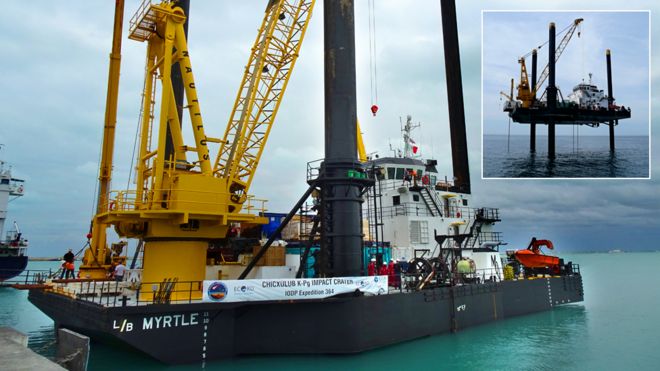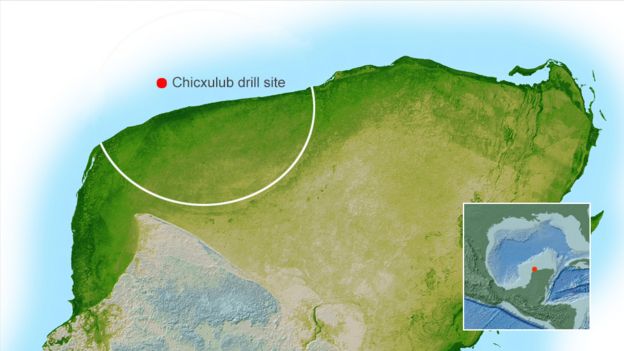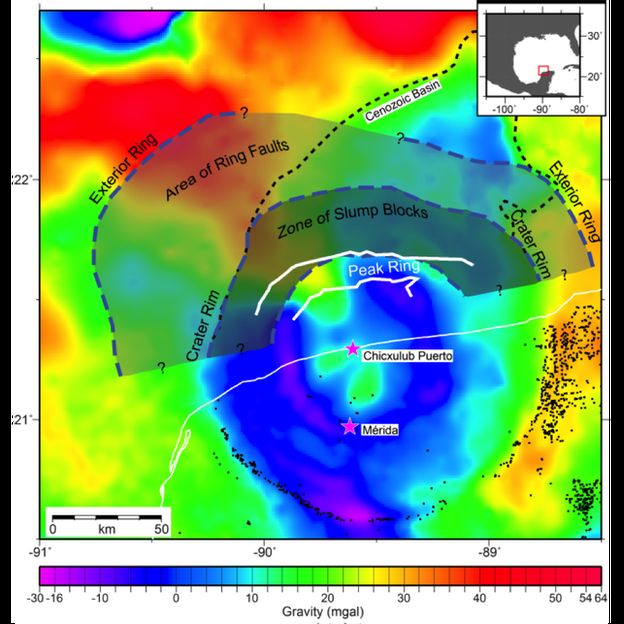- 2 hours ago
- Science & Environment
 D.SMITH/ECORD/IODP
D.SMITH/ECORD/IODP
A joint UK-US-led expedition has got under way to drill into the Chicxulub Crater off the coast of Mexico.
This is the deep scar made in the Earth's surface 66 million years ago by the asteroid that scientists believe hastened the end of the dinosaurs.
Today, the key parts of the crater are buried beneath 600m of ocean sediment.
But if researchers can access its rocks, they should learn more about the scale of the impact, and the environmental catastrophe that ensued.
They are particularly interested in a feature called the "peak ring".
This was created at the centre of the impact hole where the Earth rebounded after being hit by the city-sized object.
 NASA
NASA- An 18km-wide impactor punched a hole in the Earth's crust some 100km across and 30km deep
- This bowl then collapsed in on itself, leaving a crater about 200km across and a few km deep
- The central zone of the crater rebounded and collapsed again, leaving an inner "peak ring"
- Today, much of the Chicxulub Crater is buried offshore in the Gulf, under 600m of sediments
- On land, the crater is covered by limestone deposits, but its rim is traced by an arc of sinkholes
In geophysical surveys that can sense beneath the ocean bed, the ring looks like an arcing chain of mountains.
"We want to know where the rocks that make up this peak ring come from," explained Prof Joanna Morgan, the co-lead investigator from Imperial College London.
"Are they from the lower, mid or upper crust? Knowing that will help us understand how large craters are formed, and that's important for us to be able to say what was the total impact energy, and what was the total volume of rock that was excavated and put into the Earth's stratosphere to cause the environmental damage," she told BBC News.

The cataclysm that occurred at the end of the Cretaceous Period doomed many species, not just the dinosaurs. All the material hurled upwards would have darkened the sky and cooled the planet for months on end.
But even as it took life away, the event also opened up new opportunities for those species that survived. And the expedition team wants to know if the impact zone itself became a life cradle.
Because the asteroid hit what was back then a shallow sea area, it is likely the newly created crater was quickly filled with water.
This water would have infused the hot and fractured rocks, leaching chemicals that could then sustain micro-organisms. Very similar conditions are seen today along the volcanic ridge that runs down the centre of the Atlantic Ocean.
"So it's possible we may encounter some exotic life in the fractured rocks we drill," said Prof Morgan.
"This is very interesting for Chicxulub, but it's also fascinating to consider in terms of the early Earth or even Mars. On the early Earth, there would have been many more, larger impacts. We think life may well have originated in impact craters."
The team is using a "liftboat" called Myrtle as its drilling platform.
This will position itself close to the Yucatan Peninsula coast, jacking itself up on three legs to make for a steady station.
To reach the rocks of the peak ring, the drill will first have to navigate the thick muds on the floor of the Gulf of Mexico.
"There's less interest in the first 650m before the K-Pg (Cretaceous-Palaeogene) boundary, which is the carbonates," said Dave Smith, from the British Geological Survey.
"We've taken the view that we will open the hole to 500m and then set a casing and start coring. And we'll core continuously then down to the target depth which is 1,500m," the operations manager on the project added.
Some of the early core samples to come up should show evidence of how quickly life returned to the impact zone. Marine organisms should have re-established themselves in this sterile area on the scale of thousands of years.
Deeper cores are likely to make contact with the tsunami deposits that sloshed back and forth in the immediate aftermath of the impact.
The true peak ring rocks are at a depth of about 800m and below.
The team has given itself two months to get the job done.
"We've developed a drilling strategy that gives us multiple chances of getting to 1,500m, but at any stage you could get stuck for various reasons," explained Mr Smith.
"We're 30km off-shore, which allows us to re-supply easily. We've also timed the project so that we're pre the hurricane season. Hence starting now and trying to finish before June."
The science team has members from the US, Mexico, Japan, Australia, Canada, and China, as well as the UK and five other European countries.
The project is being conducted by the European Consortium for Ocean Research Drilling (ECORD), as part of the International Ocean Discovery Program (IODP).
Although the Myrtle carries labs to do some initial investigations, the main study will be done after the cores have been shipped to the IODP's repository in Bremen, Germany.
 D.SANDWELL/SCRIPPS
D.SANDWELL/SCRIPPS
Jonathan.Amos-INTERNET@bbc.co.uk and follow me on Twitter:@BBCAmos

No comments:
Post a Comment